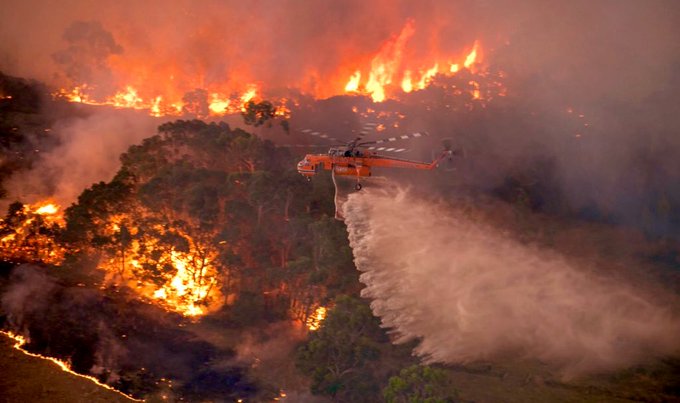By SAT News Desk
MELBOURNE, 9 January: The year 2019 was Australia’s warmest and driest year on record. This is revealed in the Annual Climate Statement 2019 of the Bureau of Metrology released today. The revelations are a big cause of concern amidst Australia’s drought and worst bushfires which have spilled into 2020. It’s connection to climate change remains potent.
Environmentalists have been warning of the dangers of climate change which continues to be denied at the highest levels. What tragedies are in the offing for humans and other living beings in the near future can be anybody’s guess.
The Statement details the Bureau’s official summary of the previous year and includes information on temperature, rainfall and significant weather.
The Statement reveals, “Australia’s mean temperature in 2019 was 1.52 °C above average, making it the warmest on record since consistent national temperature records began in 1910 and surpassing the previous record of 1.33 °C above average set in 2013.

Meanwhile the national average rainfall total in 2019 was 277 mm, the lowest since consistent national records began in 1900. The previous record low was 314 mm set during the Federation drought in 1902.”
Australia’s mean temperature in 2019 was 1.52 °C above average, making it the warmest on record since consistent national temperature records began in 1910 and surpassing the previous record of 1.33 °C above average set in 2013.
Meanwhile the national average rainfall total in 2019 was 277 mm, the lowest since consistent national records began in 1900. The previous record low was 314 mm set during the Federation drought in 1902.
“Most of this year, Australia’s climate has been dominated by a very strong positive Indian Ocean Dipole, which acted to both warm and dry Australia’s landscape, particularly from around the middle of the year.
“We also saw the influence of a rare Sudden Stratospheric Warming event high above the south pole, which acted to push our weather systems northward and compound the warmer and drier than average conditions over southern Queensland and New South Wales during spring, amplifying the fire weather.
“The other key factor at play is that Australia’s climate has warmed by more than a degree since 1910, which means very warm years like 2019 are now more likely to occur, while the trend in recent decades has been for drier winter and spring seasons in the south.”
Last year also saw some periods of significant rain in northern Queensland and northwest Western Australia.
“In January and February, we saw exceptional rainfall have a major impact on communities in northern Queensland, particularly around Townsville.
“The floodwaters were so significant they eventually made their way to South Australia, where we saw one of the largest fillings of Kati Thanda – Lake Eyre in many years.”
In recent weeks, some of the key drivers of the recent warm and dry patterns over Australia have eased. As a result, rainfall for the coming months is expected to be average to below average in the east, while wetter than average conditions are possible for much of Western Australia and South Australia. However, temperatures are likely to remain warmer than average over the rest of summer.
“Unfortunately the outlook is not indicating a widespread return to wetter than average conditions over drought and fire-affected parts of eastern Australia. But with the likely return of the monsoon by mid-January for northern Australia, it raises the chance that we could see some periods of higher rainfall move south in the coming months,” Dr Braganza said.
“It’s important the community remains vigilant to the risk of more heat and fire days this summer, particularly given how dry the country has been over the past 12 months.”
.





